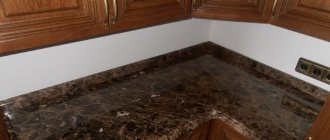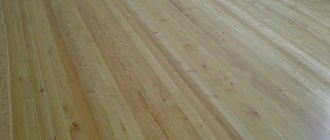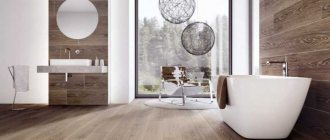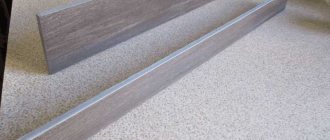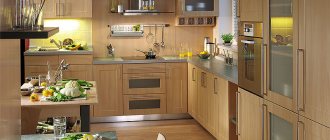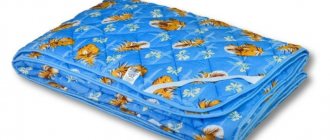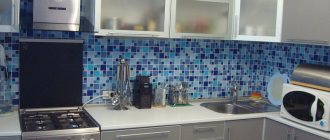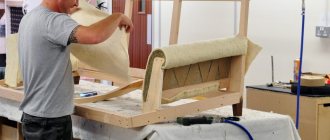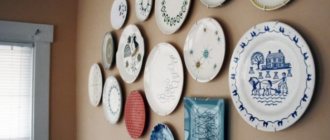When there is a desire or need to carry out major renovations in a home, the question “which floor is best to choose for an apartment” arises in almost all cases. Depending on how correctly the covering is selected, as well as how well it is installed, the overall comfort of living of any family depends. Aesthetics also play an important role - the flooring should look beautiful and please those who live in the house. And now there are many types of floor finishing. To understand how suitable this or that option is, it is worth considering the main characteristics of the most popular coatings and find out which ones are installed in certain conditions.
Which floor is better to choose for an apartment?
Choosing flooring for an apartment - TOP 9 coatings
Today there are many floor coverings, as well as their variations and combinations. A large selection allows you to choose the ideal option for each person and for each room. All types of materials differ in their properties and characteristics, each of them has its own advantages and disadvantages. And you should choose the one that will meet all the requirements and is also suitable for the price. Below is a rating of the most common flooring variations found in apartments. Let's see which one will be better in one case or another.
What kind of covering to lay on the floor in an apartment
Which floor is better to make in an apartment: analysis of various options
Categories: Articles
Have you started a major renovation? In this case, you will certainly be faced with the question of what flooring is best for the apartment? There are quite a lot of types of foundations, ranging from a banal floor screed to high-tech floors on adjustable joists, and choosing between them is by no means an easy task. Rely on builders for this? As they say, it will be more expensive for itself. All that remains is to figure it out on your own, which is what we will do in this article, in which we will look for the answer to the question, which floor is best to make in an apartment or private house? We will study all existing options, get acquainted with their features, based on which you can draw your own conclusions.
What floor to make in the apartment photo
No. 9 - Carpet
This pile flooring option is very widespread. Carpet is made from natural or synthetic fibers and can have different pile lengths. By the way, there is a type of material even without lint at all. The “hairs” are fixed on a jute, felt or rubber base.
Carpet - operation and care
pros
- inexpensive
- Beautiful
- easy to lay
- suitable for bedroom or living room
- lots of color variations
Minuses
- difficult to clean
- quickly loses its appearance
- may cause allergies
- not suitable for every room
Carpet
You can lay carpet in the same way as linoleum; there is nothing complicated here, which means we can talk about ease of installation. The material is quite cheap and looks like carpet. As a rule, it is laid in bedrooms, living rooms, and living rooms. It is not suitable for a kitchen or bathroom - debris and dust will get stuck in the pile; if it gets wet, the material will have to be dried, and after drying, unsightly stains may remain on its surface. In short, carpet, although easier to care for than a regular carpet, is still not so convenient. In order to remove, for example, a juice stain from it, you will have to clean it with special means. By the way, laying such material in the hallway is also a bad idea.
Some types of carpet
Carpet prices
Carpet
Expert opinion
Afanasyev E.V.
Chief editor of the pol-exp.com project Engineer.
Another disadvantage of carpet is the rapid loss of appearance. It's only beautiful when it's new. Old carpet looks bad, and updating it even with special tools simply won’t work. And in general, dust that accumulates between the fibers is very difficult to remove from there - the material is not suitable for allergy sufferers.
Stages of laying carpet on a wooden floor
No. 8 – Linoleum
This is one of the most common variations of flooring. Its popularity is due to its low price and durability, as well as very simple installation and a lot of color variations, which make it possible to choose linoleum for absolutely any interior.
Linoleum
Linoleum is usually a synthetic material, but there are also natural options. The natural look is rarely used now, since it is very expensive and it is easier to lay some other covering option instead. But in any case, linoleum is a durable, high-quality and at the same time budget material that is suitable for installation in almost any room.
The structure of household linoleum
There are several variations of this coating, differing in thickness and level of strength. The thickest type is usually installed in commercial premises and is not recommended for residential installations. The reason is that it contains a large amount of harmful impurities that are hazardous to health. But standard thin linoleum is quite suitable for use in an apartment, and its level of strength will be enough for several years with care and proper installation.
Types of linoleum
On a note! Linoleum can be single-layer regular, as well as thick with a backing, which allows you to additionally insulate the floors under your feet.
The material can be laid on plywood, concrete, wood - on almost any type of rough foundation. You can lay it in any room, with the exception of the bathroom - it is not recommended to do this there, since linoleum does not allow water to pass through, which means that if it gets under it, it will remain there and create favorable conditions for the development of mold. Otherwise, household-type material is completely safe for humans, even though the non-natural type is most often used.
Linoleum is sold in rolls
Linoleum is quite durable. But he is afraid of piercing and cutting objects. They can easily damage and ruin it. In case of severe cuts, the entire coating will have to be changed; small ones can be covered with a patch, but the defect will still be visible to the eye. Linoleum does not require special care.
Classes of linoleum coating used in residential premises
Prices for linoleum
Linoleum
What are the properties of linoleum
No. 7 – Ceramic tiles
Tiles are a universal, strong, durable and beautiful type of coating that will never lose its popularity. Material that was previously installed mainly only in the bathroom or kitchen can now be used in almost any corner of the apartment. Yes, it is dense and cold to the touch, but it is quite possible to solve the problem of a cool floor by installing a heating system. But the tiles are not afraid of moisture, look beautiful, and are ideal for almost any interior style. It can be called a universal coating.
Ceramic tile
On a note! In the bathroom and kitchen, tiles can be laid without a base heating system, but if this material was chosen for the bedroom or living room, then installation of a heated floor system is almost mandatory.
Floor tiles come in a variety of colors and sizes. This material is characterized by a certain complexity of installation, but after installing it once, you can forget for a long time that the floors need repair. Laying can be done on almost any surface - the main thing is that they are sufficiently rigid and even.
Multicolored ceramic tiles
The tile is easy to clean from absolutely any dirt, it is not afraid of water, heating or cooling, and does not fade in the sun. If treated with care, it can serve for decades and does not deform. The only thing she is afraid of is falling heavy solid objects and improper installation. The material can crack if something heavy is dropped on it, and if voids are left underneath it during installation, then it will fail in that place and break. Fortunately, damaged tiles are easy to replace with new ones.
The floor is laid with hexagonal tiles
Advice! You can create a beautiful panel on the floor from ceramic tiles if you use different sizes and colors and lay the elements according to a certain pattern.
Panel of tiles on the floor
By the way, ceramics is an absolutely inert and environmentally friendly material. It will not cause harm to health and will not provoke allergies under any circumstances.
Floor tile laying technology
pros
- durability - can last for decades
- beautiful appearance
- durable after installation
- not afraid of water, heat
- compatibility with heated floors
- environmentally friendly natural material
- various sizes
- suitable for any room
Minuses
- it's uncomfortable to walk barefoot
- complex installation
- can be easily broken
Quartz vinyl tiles
No. 6 – Self-leveling floor
This type of coating was previously used only in various production workshops, but is now also used for home improvement. Now many people are choosing self-leveling floors, and there are many reasons for this. For example, self-leveling floors look beautiful, they turn out perfectly smooth, can have absolutely any color and even an original design, even printing photographs.
Self-leveling floor
On a note! 3D drawings, which are often done on self-leveling floors, can look very realistic. For example, in the bathroom you can create a “lake” under your feet or a whole oasis.
What is self-leveling floor
This is an inert material that is not afraid of either water or heat, and if desired, you can make heated floors underneath it. By the way, if a self-leveling floor is installed in a bedroom or living room, then, as in the case of tiles, heating is almost mandatory, otherwise it will be uncomfortable to walk on the base barefoot. Also, this coating option is not afraid of almost any impact and is easy to clean to an almost sterile state.
Mixtures for self-leveling floors
Expert opinion
Afanasyev E.V.
Chief editor of the pol-exp.com project Engineer.
The main disadvantage of self-leveling flooring is the complexity of its installation. Not everyone will be able to fill such a foundation on their own, since the installation process has a lot of subtleties and nuances. It is better to entrust this matter to a professional. But properly made floors are durable and beautiful. Another disadvantage is the tendency to scratches if the floor is glossy.
Prices for self-leveling floors
Self-leveling floors
Stages of installing a gypsum self-leveling floor
No. 5 – Parquet board
A material resembling something between parquet and laminate. Parquet boards are made from natural wood, they are easier to install than real parquet, and they are much easier to care for. The coating elements look like long boards with several rows of dies in the finishing layer.
Parquet board
The material is much cheaper than regular parquet, and that is why it is often chosen if you want to get a beautiful, but relatively inexpensive floor. The color can be very different, but, as a rule, these are woody shades.
The structure of the parquet board
Like regular parquet, the board also sometimes needs sanding. This will update the appearance of the coating. Installation is relatively simple and is done using floating floor technology - no glue. If desired, such a floor can be easily dismantled. Service life - up to 20 years.
Types of decorative layer of parquet boards
pros
- environmental friendliness
- ease of installation
- beautiful appearance
- made of natural wood
- relatively low cost
- installation without glue
Minuses
- sometimes you need to cycle
Prices for parquet boards
Parquet board
Wooden floor for a kitchen in a private house
When choosing a wooden floor for a private home, there are several important points to remember. When installing a wooden floor in the kitchen of a private house, it is important to take care not only of anti-corrosion waterproofing, which will protect the floor from external factors, but also of anti-filtration protection, that is, protection from groundwater and other aggravating factors. In addition, it is necessary to take care of anti-corrosion waterproofing, which will protect the floor from spilled moisture, fumes and other external influences.
No. 4 - Cork covering
This is an expensive and not the most practical floor covering option. But the material is environmentally friendly, it is pleasant to walk on it even with bare feet, it is elastic and, in general, even by itself creates coziness and comfort in the room.
Cork covering
Cork is a material that not only makes the floors warmer to some extent, it also insulates sound, and the neighbors below will not hear all noise from the apartment, except the loudest. This type of coating is considered elite and is quite expensive.
Forms of production of cork flooring
Installation of cork flooring can be done in any room, except those where the level of humidity is high, since the material will simply begin to absorb moisture and deteriorate. Also, installation must be done on a flat and solid base. You can't put a cork on bare concrete either - you must use a backing. Overall installation is very simple.
Cork is especially popular in children's rooms
Cork is available in the form of slabs or rolls. It must be installed using special glue. Some options have a layer of immediately applied adhesive component in production, which allows you to fix the material on the floor. The upper part of the material is coated with a special compound that protects the cork from moisture.
pros
- heat and sound insulation properties
- environmental friendliness
- easy installation
- high strength
- elite material
- it's nice to walk on it barefoot
- suitable for any room except the bathroom
- does not bend and can withstand heavy loads
- not afraid of rising or falling temperatures
Minuses
- it costs expensive
- cannot be placed in the bathroom
Cork prices
Cork covering
Installing and repairing wood floors in the kitchen
Today, many people, when starting a renovation, try to do as much work as possible with their own hands in order to save money. Is it possible to lay a wooden floor yourself? This is possible, provided that you have some construction skills and strictly follow the instructions for performing such work.
So, when installing a wooden plank floor, the frame is first assembled, laying the wooden blocks evenly, and after that they begin to lay the floor. As a rule, the flooring is made of boards with a tongue-and-groove fastening system on the side and end faces. Assembly can be carried out directly on a flat base prepared in advance (from plywood, OSB boards) or on logs. The use of logs eliminates the need to level the base and makes it possible to additionally insulate the floor with gravel, thermal insulation materials, etc. After installation is completed, the floor is sanded (if necessary) and covered with stain or varnish.
Helpful advice: when laying a wooden floor of any kind, the humidity in the room should not be too high, so that the floor does not deform later. Experts also advise that before laying, keep the boards in the room where they will be laid for 24 hours to prevent cracks from appearing in the future.
Finishing the floor with parquet, regardless of the type of parquet, is done according to the same criteria. First, carefully level the surface on which the parquet will be laid. Then a thin (up to 3 mm) special moisture-proof substrate is laid on the screed. After this, the actual assembly of the parquet flooring begins. The simplest assembly method is “floating”, in which the floor elements are attached not to the base, but to each other with a deviation of 10 mm from the walls. If the room has a large area, then to ensure the reliability of the parquet floor, it is attached to dowels or nails or special glue is used.
When repairing a wooden floor, a coating inspection is first carried out to analyze its condition. Repairing a wooden floor may involve filling holes, cracks, eliminating squeaks, repairing loose boards, or repairing damaged boards.
If the boards are worn out on the front side and are in good condition overall, it makes sense to re-lay the floor, laying the boards with the wrong side up.
If the boards are completely damaged in a small area, there is no need to dismantle the entire floor. It is enough to remove the damaged boards between the nearest joists and replace them with new ones, securing them with nails or self-tapping screws to wooden blocks previously nailed to the joists.
If cracks appear after installing new boards, use a special wood putty to eliminate them, and then apply a decorative protective coating (varnish or paint) to the floor.
In order not to frequently repair a wooden floor, you need to provide it with proper care, which consists of maintaining optimal temperature and humidity in the room and timely treating scratches with repair varnish.
No. 3 – Piece parquet
One of the oldest flooring options that still remains popular. Parquet consists of small boards laid according to a certain pattern. They are laid individually using a special adhesive composition, which is why the installation of such a coating is long, expensive and complicated.
Piece parquet
On a note! Modern parquet does not have to be laid piece by piece. There are variations of the material when several elements were combined into a single larger system during production. This means that installation will go faster and easier.
Block parquet is the most durable type of parquet
Parquet is created from pure wood. Moreover, the top layer of the plank is, as a rule, made of elite species. Ash, oak, beech and other durable wood options are commonly used. Accordingly, the pattern of the parquet is the pattern of wood. The material is safe and environmentally friendly. It will not harm your health. The coating also has good heat and sound insulation, it is pleasant to walk on and can be installed in all rooms except the bathroom and toilet.
The process of laying block parquet
Expert opinion
Afanasyev E.V.
Chief editor of the pol-exp.com project Engineer.
Parquet is an expensive type of flooring. But it also looks expensive, beautiful, solid. It is also not easy to care for - it needs to be scraped, rubbed, and so on. But this is one of the most durable floor covering options, lasting for decades - up to 50 years, according to manufacturers. It just needs to be regularly subjected to special procedures, and it will be like new again. However, in order for parquet to last a long time and retain its beautiful appearance for a long time, it must be laid in a room with a certain level of humidity and temperature.
Block parquet
Prices for piece parquet
Piece parquet
Types of wooden floors
Parquet board
Parquet is traditionally considered one of the most prestigious floor coverings, due to its luxurious appearance and high cost. In addition, parquet floors also have such an important advantage as the possibility of their restoration. With the help of modern paints and varnishes, you can maintain the original appearance of parquet for at least 10-15 years. After this period, if necessary, it is sanded or scraped, and treated with varnish, and again a parquet floor with excellent aesthetic and performance characteristics is obtained. That is, the high price of such a floor is completely justified.
There are several types of parquet:
- Parquet board, which is a two- or three-layer structure that has increased resistance to humidity and temperature changes. The parquet board has a size of up to 2.5 m, which ensures its simple and quick installation.
- Piece parquet, which consists of small planks, secured during installation using a tongue-and-groove system. As a rule, hard wood species are used for their manufacture: oak, ash, beech. Most often, piece parquet is laid using one of the traditional methods (herringbone, wicker, etc.), and the color of the planks can vary to create the desired pattern.
- Parquet tiles, which can have a standard size of 400*400mm or another. The use of parquet tiles greatly simplifies the work and speeds up the process of finishing the floor.
- Panel parquet, which consists of a wood base and a front layer in the form of planks made of hard wood.
OSB boards
Oriented strand board, or OSB, is a modern building material for which flat rectangular wood chips are glued together with a special waterproof resin under high temperature and pressure. The resulting material has all the beneficial properties of wood (since it consists of 95% wood material), but surpasses it in terms of elasticity and strength, thanks to a special chip laying pattern.
In addition, a floor made from OSB boards, compared to other wooden flooring, has a number of other advantages in the form of higher moisture resistance and resistance to aggressive environments without additional processing, and ease of installation.
Solid floor board
Solid plank flooring is an example of practicality and durability. Its undoubted advantages include:
- durability (the service life of such floors is on average up to 60 years or more;
- environmental friendliness;
- high heat and sound insulation characteristics;
- ability to withstand heavy loads;
- ease of installation and repair.
The most affordable, and therefore widespread, are floors made from soft wood boards - pine and spruce. Oak, beech or ash boards have very high durability and strength, however, they are more expensive.
The cost of a floorboard is affected by its dimensions (length, width and thickness) and the type of wood. The length of the board can be from 500-600mm to 2500mm or more, thickness - 20-22mm. As for the width, it can be different, however, with the natural shrinkage of wood, wide boards crack more often.
No. 2 - Floorboard
The most pleasant feeling and best option for human health is a regular floorboard. It is a natural wood floor, created without any adhesives, that is almost the best for any home.
Batten
Installation of the floorboard is carried out using previously installed and secured joists. Under the floor covering itself, materials such as ecowool are laid as insulation. And wood itself, due to its structure, retains heat well in the house, plus it is also tactilely pleasant.
Sorting solid boards
Another advantage is the durability of wood floors. When installed correctly and properly cared for, wood floors can last for decades. And the environmental friendliness of the material makes it an ideal option for those who care about their health.
Solid wood board is an absolutely natural, environmentally friendly material
Wood flooring has excellent heat and sound insulation properties and does not even require additional sound insulation. This is a great option for families with children and simply active people.
Wooden flooring is best suited for installation in a bedroom or living room, or children's room. But in a bathroom or kitchen, wood will quickly deteriorate due to high humidity. Therefore, for such premises it is better to choose another option. Another drawback of wood is its tendency to absorb odors that hang in the house. But getting them out is not an easy task. Also, due to the installation features (the need to install joists), you need to take into account that wooden floors will slightly reduce the ceiling height - for some this may be a critical factor. And over time, the plank floor may begin to creak. Fortunately, this deficiency is usually quite easy to correct.
The most environmentally friendly flooring option is wood.
Surprisingly, wood flooring doesn't cost as much as it could. In fact, it will cost much less than some other coating options. But installing it is not the easiest and not the cheapest task.
pros
- looks good
- environmentally friendly material - natural wood
- tactilely pleasant
- durable
- good heat and sound insulation properties
- ease of care
- inexpensive option
Minuses
- complex installation
- may start to creak
- not suitable for wet areas
Prices for flooring boards
Batten
Advantages and disadvantages of a wooden floor for the kitchen
One of the main advantages of a wooden floor is its environmental friendliness, since it is made from absolutely natural material. Wood flooring is beautiful, it gives the kitchen a respectable look, emphasizes its design and makes it very cozy. In addition, such floors retain heat well due to the low thermal conductivity of wood.
Helpful tip: a wooden floor looks most advantageous in a kitchen with an interior in a classic or country style, as it fits perfectly with wooden furniture and corresponding accessories.
However, when choosing a wooden floor for the kitchen, you should also take into account its disadvantages, such as:
- low resistance to moisture and temperature changes. Moreover, both an excess of moisture, from which it begins to rot, and a lack of it, which leads to cracking of the wood, are equally destructive for a wooden floor;
- the need for constant care and regular treatment with special products designed to protect wood;
- high cost of both the material itself and the work associated with its construction.
If a wooden floor still seems to you the best choice, some of its disadvantages can be neutralized if desired. For example, using special oils or varnishes, the wood structure can be made less porous and more resistant to the absorption of dirt and moisture. It is better if a natural wood floor is used in the dining area, in addition to the tiles or porcelain stoneware that will be used in the work area.
No. 1 - Laminate
Among all floor coverings, this option is the most commonly used. Why is laminate so popular? It's simple: it's inexpensive, easy to install, practical, beautiful type of covering that's easy to install yourself.
Laminate
Laminate is a material consisting of lamella boards with special locking joints that allow the floor to be assembled without the use of glue. However, types of laminate that are glued on also exist, but now such options are rarely seen on sale. When assembling the floor, the locks of two adjacent lamellas are connected to each other until they click, and thus two adjacent elements are securely fastened to each other. This is how the entire coating is assembled.
Laminate installation process
The laminate itself consists of several layers. In the middle there is material from wood processing waste, at the bottom of the lamella there is a protective layer, and above the wood material there is a layer with a pattern, usually imitating wood. On top of it is a laminated layer, which can be smooth or have a wood structure. The top and bottom layers are not afraid of moisture and protect the material from it and a number of other influences - for example, abrasion. But still, laminate itself is afraid of water. And, similar to most of the options described above, it cannot be installed in a bathroom or toilet. But for the kitchen, laminate flooring is quite suitable.
Laminate structure
The material as a whole is not capricious, but requires special attention. Thus, installation of the laminate should be carried out on a flat surface free of debris using a special substrate. Otherwise, the coating will begin to creak over time and quickly become unusable. It is also important to understand that moisture is dangerous for laminate flooring, and you should not spill anything on it, and if this happens, it is important to quickly wipe the floor to remove the moisture.
Laminate DECORIA
On a note! Laminate is not the most durable material. But if you choose the right strength class (and the laminate has several of them), then this coating will last a very long time if the operating conditions are met.
pros
- looks good
- inexpensive
- There are several strength classes
- ideal for decorating floors in almost all types of rooms
- easy installation
- It is not necessary to use glue during installation
- tactilely pleasant
- can be bought at any hardware store
Minuses
- doesn't like moisture
Video - Comparison of different floor coverings
Choosing flooring for different rooms
Covering the base underfoot is an important element in any room.
Not only the attractiveness of the room, but also the comfort in it will directly depend on how the floor is finished. Materials are chosen mainly based on their cost, beauty and personal wishes. However, it is important to consider some basic operational characteristics of the selected option. For example, there is a task to finish the base of an average apartment or house. In any case, dwellings have at least one room, an entrance hall, a kitchen area and a bathroom/bathroom. And the microclimate conditions in all these rooms will be different. For example, the humidity in the bathroom is in any case higher than in the living area. This is due to the fact that in the bathroom a person takes a shower, often turns on the water, and performs various tasks related to water consumption. And even if all communications are done well and have no leaks, the humidity will still be increased.
An original solution for the kitchen area
If we talk about the kitchen area, then during cooking, pieces of food often fall on the floor, oil drips somewhere, and so on. That is, the kitchen area needs to be cleaned and washed much more often than the same bedroom or living room. And the requirements for floor covering in both cases will be completely different than in a residential area. For example, the floors in the bathroom should be able to withstand moisture well, and in the kitchen they should be easy to clean and practical. That is, as an option, you can lay ceramics.
Ceramic tiles for the kitchen
The biggest test goes to the bases in the hallway. Here there is most of the dirt that is dragged from the street, a lot of sand, and often moisture brought on shoes or on the same umbrella or jacket after rain gets on the base. Even a children's sled, brought from the street and poorly placed, can damage the material that is unsuitable for the hallway. So for a room of this type it is worth choosing a dense, hard material that is resistant to a wide variety of loads. The ideal option is ordinary ceramics. This material will not be afraid of any of the above and will always look like new. But even a very durable self-leveling type of base can still be scratched and damaged.
Linoleum for the hallway
As an option, you can lay linoleum or a good expensive laminate in the hallway, but only of a high strength class. The remaining coatings are completely unsuitable - they simply will not withstand the entire level of load.
If we talk about the bedroom, then the coating should be tactilely pleasant and comfortable, as well as environmentally friendly. Here a person will rest, replenish his strength and generally stay for a very long time during the day, plus he walks barefoot. So there should be the best coverage, safe and comfortable to use.
Parquet floor in the bedroom
So, for a room where they sleep and relax, it is best to choose parquet or ordinary natural wood. You can choose carpet or laminate, but in this case these materials are inferior in properties to those mentioned above (at least in terms of environmental friendliness). Laminate flooring can only be laid if there is an insulating substrate or warm floor underneath it, otherwise it will be uncomfortable to walk on it barefoot.
Laminate flooring in the bedroom
Important! Carpet should not be installed in the bedroom where a person with allergies sleeps. This coating accumulates dust, which can trigger an attack.
On a loggia or balcony, the coverage will depend on whether the room is glazed and insulated and whether it is protected from various influences from the street. But the main requirements for any material in such areas of the apartment are durability and resistance to moisture. If everything here is insulated, then inside you can put exactly the same covering as in the living area - alternatively, the same familiar laminate. In other cases, it is worth stopping at ceramics.
Laminate flooring for the balcony
Table. Coating options depending on the type of room.
| Room | Types of coatings |
| Is there a bathroom? | The most basic are ceramic tiles, as well as a self-leveling option, waterproof laminate. |
| Kitchen, hallway | Ceramics, self-leveling flooring, durable and thick linoleum, good laminate or cork of a high class of strength and protection. |
| Loggia, balconies | Ceramics. |
| Bedroom and children's room | Laminate, wooden flooring, regular parquet, parquet boards, carpet, with the exception of the children's room, cork. |
| Living room | Any option, even tiles, provided that a heated floor is installed. |
Tiles are the best option for bathroom floors
Requirements for the characteristics and properties of a kitchen floor
So, taking into account the purpose and conditions in which we have to use floor surfaces where we cook, eat, drop hot pans, spill greasy liquids, constantly tidy up using various detergents and cleaning products, the following requirements logically follow from them:
- The floor surface must be wear-resistant and durable.
- It is good to resist moisture, putrefactive phenomena, the formation of harmful fungi and mold.
- Cleaning and maintaining them should not be a problem.
- Tolerate physical and mechanical influences.
- Tolerate the effects of “chemicals” included in cleaning products and detergents.
- Have an attractive appearance.
- Well, when deciding what to make a kitchen floor from, for many people the optimal price-quality ratio of the chosen flooring material is very important.
Note! Whatever flooring options you consider in the kitchen, the first question that should concern you is their safety for humans.
- The main requirement is safety for humans:
- during operation, when walking in the kitchen, people should not slip on it;
- the flooring material itself should not emit harmful substances, and in the event of a fire, it should not create a rapid concentration of toxic emissions that are fatal to people.
Photo: Having laid a wooden floor in the kitchen, be prepared to constantly care for it and periodically update its surface protection with paints, mastics, and waxes.
Note that not all of the above wishes ideally and 100% correspond to a kitchen floor made of wooden material, which we will talk about in this article. But it is worth noting that the design relevance of wood as a material for the floors of our kitchens has not gone away, otherwise other floor coverings (ceramic granite, ceramics, laminate, linoleum) stylized as natural wood would not have been produced.
Wood is perfect for lovers of classic style, for those who want harmony of the floor with wooden furniture in the kitchen. A wooden floor will simply fit perfectly into a country-style kitchen.
Note! Since wood floors are still susceptible to moisture and temperature changes, it is possible to use them in combination with other floor coverings in the kitchen. For example, in the dining area, use wood for the floor, and in the direct cooking area, use the same ceramic tiles.
In any case, starting from the moment when you decide what to make the floors from in the kitchen, when you choose the methods of their installation (laying) and directly carry out the work on their installation, you must comply with the recommendations and requirements of regulatory documents on construction.
Construction recommendations, norms and rules
A home craftsman who likes to do everything with his own hands and will look for answers to questions - what to make kitchen floors from, how to work with these materials, needs to know the relevant building codes and rules.
On the topic of the article, it will be useful to familiarize yourself with the following regulatory documents on construction:
- SNiP 2.03.13 – 88 “Floors”, (updating SP 29.13330.2011).
- GOST 8486 – 86 “Softwood lumber. Technical conditions".
- GOST 2695 – 83 “Hardwood lumber. Technical conditions".
Note! Following the recommendations of construction documentation must be followed at all stages of floor installation, from their design and selection of the appropriate floor covering, accompanying building materials (for example, primers, adhesives, impregnations, etc.), to the direct work on their installation.
Tips and solutions
And in the end, we will try to summarize and provide general recommendations for choosing a coating for the base and advice given by experienced users. The basic requirements for any coating are as follows:
- easy care;
- safety for human health;
- beauty;
- pleasant tactile sensation;
- durability.
Choosing flooring for an apartment
These indicators may vary in priority and other parameters depending on the requirements of the homeowner, budgetary capabilities and personal wishes. For some, the main indicator when choosing a material will be its price, while for others - strength and environmental safety. And all people will have different approaches to the choice of material for the foundation, each from their own “bell tower”. Thus, you need to start choosing coverage with a thorough analysis of your own life, your habits and the behavior of your family members.
There are a number of factors to consider when choosing flooring
Important! Even the composition of your family can influence which coverage you should choose. For example, some finishing options are completely unsuitable for children (hazardous or hazardous from an environmental and health point of view).
If children and animals live in the house, then one of the main requirements for the base coating will be compliance with the required environmental friendliness indicators. That is, the material must be safe for health. These are ceramic tiles, wood, parquet. Also, the chosen option must be non-slippery, non-traumatic and resistant to various influences. It is desirable that it is easy to clean - just imagine that a child painted the newly laid carpet with his paints. Or your favorite Labrador ran all over it after playing in the dirt outside. It is immediately clear why this covering option is completely unsuitable for a house where such residents live.
Light-colored carpeting is not the best option if there is a child in the house.
If you have a habit of walking barefoot, then in most of the apartment the floors should be tactilely pleasant, not cold in sensation. Otherwise they will be uncomfortable to use. Alternatively, there may be wood, fleecy coverings, or materials that imitate wood covering. But you can also lay tiles if you worry about heating them. It is important to understand that constantly running heated floors waste a lot of electricity, which will definitely affect utility bills.
Expert opinion
Afanasyev E.V.
Chief editor of the pol-exp.com project Engineer.
If the apartment is located in a region where air humidity is high, or it is located on the ground floor, then it is worth purchasing coatings that are not afraid of high levels of humidity. Tiles, moisture-resistant laminate, linoleum, self-leveling flooring are good options.
Beautiful self-leveling floor in the apartment
Important! The closer to the basement the room being renovated is, the higher the humidity level in it.
You will also have to take into account what building the apartment is located in or what kind of floors it previously had. For example, not all houses can be filled with screed. It is usually installed in new buildings or houses that structurally allow this to be done. In most old panel houses, this option for a rough foundation is unacceptable. This means that coatings that require screeding will have to be completely eliminated.
It is important to think about what color of the floor you would like to see, how harmoniously the texture and shade of the floor covering will be combined with the rest of the interior. Dark looks solid and contrasts well with a restrained and light interior. But a room with such a base needs good lighting. For dark rooms, it is better to choose a light floor - it will be fresher and will not absorb light.
Combination of colors in the interior
Also, you should not make one covering option for the entire apartment. This will be a mistake, especially for small rooms. The coating should be chosen depending on the purpose of the room. By the way, floors with a pronounced relief coating are also not the best option. Keeping them clean will not be easy - dirt will get into all these reliefs and grooves if they are very deep. At the same time, in the bathroom, for example, it is worth putting a relief covering in order to reduce the risk of injury to the floor. It's easy to slip on glossy surfaces if you spill water on it.
